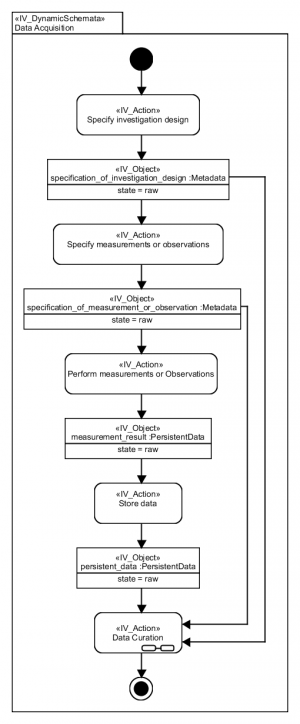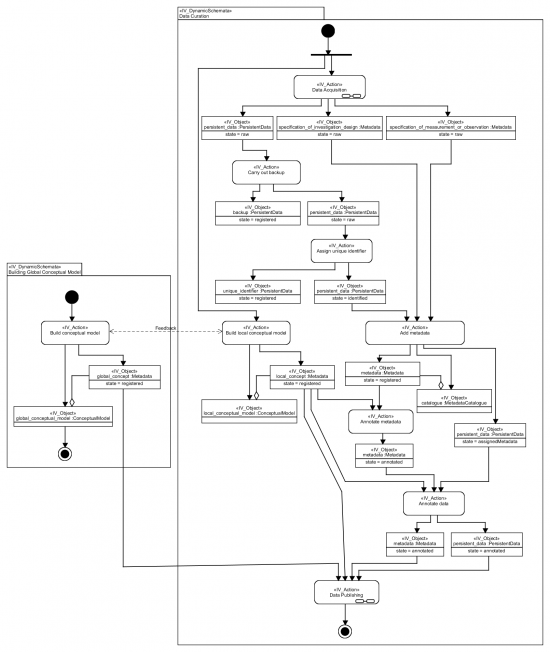Difference between revisions of "IV Lifecycle in Detail"
(Created page with "This section expands the '''IV Lifecycle Overview''' of the alignment between the information viewpoint and the data lifecycle. The descriptions use...") |
|||
| Line 11: | Line 11: | ||
{| style="width: 95%;" | {| style="width: 95%;" | ||
|- | |- | ||
| − | | style="width: 60%; padding: 10px 10px | + | | style="width: 60%; padding: 10px 10px 80px 10px"| |
=== <span style="color: #BBCE00">Data Acquisition</span> === | === <span style="color: #BBCE00">Data Acquisition</span> === | ||
| Line 38: | Line 38: | ||
|- | |- | ||
| style="background-color:#ffffff;"| [[File:IVEvolutionAcquisition03.png|300px]] | | style="background-color:#ffffff;"| [[File:IVEvolutionAcquisition03.png|300px]] | ||
| + | <div style='text-align: right;'>'''Notation'''</div> | ||
| + | |} | ||
| + | |} | ||
| + | |||
| + | {| style="width: 95%;" | ||
| + | |- | ||
| + | | style="width: 50%; padding: 10px 10px 10px 10px"| | ||
| + | === <span style="color: #BBCE00">Data Curation</span> === | ||
| + | |||
| + | The data curation phase encompasses the actions that support the the long term preservation and use of research data. The main product of this set of actions is persistent data in a stable state (annotated data). The following paragraphs explain the detailed diagram of how the IV actions can be combined to support data curation. | ||
| + | |||
| + | <p style="background-color: #fcfcfc; border-radius: 5px; border: 1px solid #ccc; padding: 10px 20px 10px 20px;"> | ||
| + | '''Note'''<br> | ||
| + | This example is provided for illustrative purposes. The example shows one of many alternatives for performing data curation. Other IV actions and IV objects can be introduced at this stage, for instance: Check quality, Register metadata, or Publish metadata. Actions and objects not described in the IV of the ENVRI RM can also be incorporated. | ||
| + | </p> | ||
| + | |||
| + | '''Data Acquisition''': The first action is Data Acquisition, the phase of the data lifecycle that precedes data curation. This action produces three IV Objects: PersistentData, SpecificationOfMeasurementsOrObservations and SpecificationOfInvestigationDesign. | ||
| + | |||
| + | '''Carry out backup''': As soon as data are available to the RI a backup can be made, independently of the state of the persisted data. This can be done locally or remotely, by the data owners or by dedicated data archiving centres. | ||
| + | |||
| + | '''Assign Unique Identifier''': Data needs to be uniquely identified for correct retrieval and processing, the unique identifier can be local to the RI or global, to be used from outside the RI. As such it can be a simple numerical value assigned by the RI DBMS or a specific PID assigned following the standards of an external PID provider. | ||
| + | |||
| + | '''Add metadata''': This action uses the specifications of investigation and measurements to facilitate the understanding of the associated persistent data object. In addition to this data the RI can add timestamps, and other identification data as metadata. Once the data is correctly stored and identified, and the corresponding metadata has been also created, persistent data can be linked to metadata. | ||
| + | |||
| + | '''Annotate data''': Data is further enriched with additional metadata which can correspond to a specific ontology for the research field. | ||
| + | |||
| + | '''Annotate metadata''': Metadata can also be further enriched with additional metadata which can correspond to a specific ontology for the research field. | ||
| + | |||
| + | '''Build conceptual model''': The building of a '''local conceptual model''' mirrors the wider research community efforts to build a global conceptual model. In this set of activities concept are added to the local conceptual model of the RI. The conceptual model is made of the composition of concepts, which are used to help people know, understand, or simulate a subject the model represents. The pairing of data and metadata using semantic annotations creates a local concept (a new metadata object) and changes the state of the persistent data object to annotated. | ||
| + | |||
| + | '''Global conceptual models''' are ontologies, thesauri, dictionaries, or hierarchies built by a larger communities than a single RI, such as GEMET, DOLCE, SWEET. This action normally happens outside of the RI's main activities. Trough feedback mechanisms RIs participate in the creation of global conceptual models while developing their own models.. | ||
| + | |||
| + | '''Data Publishing''': Once data have been curated, the next phase of the data lifecycle is data publishing. | ||
| + | |||
| + | | style="width: 50%; padding: 10px 10px 420px 25px"| | ||
| + | {| class="wikitable" | ||
| + | |- | ||
| + | ! style="padding: 10px"| <div style='text-align: left;'>'''Data Curation'''</div> | ||
| + | |- | ||
| + | | style="background-color:#ffffff;"| [[File:IVEvolutionCuration05.png|550px]] | ||
<div style='text-align: right;'>'''Notation'''</div> | <div style='text-align: right;'>'''Notation'''</div> | ||
|} | |} | ||
Revision as of 15:30, 27 March 2020
This section expands the IV Lifecycle Overview of the alignment between the information viewpoint and the data lifecycle. The descriptions uses the IV Information Objects and IV Information Action Types to a greater extent providing a deeper insight into the processing of information objects by the RI.
The notation for the diagrams in this section is as follows. The rounded rectangles represent IV actions on data and the straight rectangles represent instances of information objects at different stages. The arrow lines link actions and objects as follows: arrows leaving an action connect to IV objects created by the action while arrows entering an action connect IV objects to actions using them.
Data Acquisition Data Curation Data Publishing Data Processing Data Use
Data CurationThe data curation phase encompasses the actions that support the the long term preservation and use of research data. The main product of this set of actions is persistent data in a stable state (annotated data). The following paragraphs explain the detailed diagram of how the IV actions can be combined to support data curation.
Note Data Acquisition: The first action is Data Acquisition, the phase of the data lifecycle that precedes data curation. This action produces three IV Objects: PersistentData, SpecificationOfMeasurementsOrObservations and SpecificationOfInvestigationDesign. Carry out backup: As soon as data are available to the RI a backup can be made, independently of the state of the persisted data. This can be done locally or remotely, by the data owners or by dedicated data archiving centres. Assign Unique Identifier: Data needs to be uniquely identified for correct retrieval and processing, the unique identifier can be local to the RI or global, to be used from outside the RI. As such it can be a simple numerical value assigned by the RI DBMS or a specific PID assigned following the standards of an external PID provider. Add metadata: This action uses the specifications of investigation and measurements to facilitate the understanding of the associated persistent data object. In addition to this data the RI can add timestamps, and other identification data as metadata. Once the data is correctly stored and identified, and the corresponding metadata has been also created, persistent data can be linked to metadata. Annotate data: Data is further enriched with additional metadata which can correspond to a specific ontology for the research field. Annotate metadata: Metadata can also be further enriched with additional metadata which can correspond to a specific ontology for the research field. Build conceptual model: The building of a local conceptual model mirrors the wider research community efforts to build a global conceptual model. In this set of activities concept are added to the local conceptual model of the RI. The conceptual model is made of the composition of concepts, which are used to help people know, understand, or simulate a subject the model represents. The pairing of data and metadata using semantic annotations creates a local concept (a new metadata object) and changes the state of the persistent data object to annotated. Global conceptual models are ontologies, thesauri, dictionaries, or hierarchies built by a larger communities than a single RI, such as GEMET, DOLCE, SWEET. This action normally happens outside of the RI's main activities. Trough feedback mechanisms RIs participate in the creation of global conceptual models while developing their own models.. Data Publishing: Once data have been curated, the next phase of the data lifecycle is data publishing. |
|

